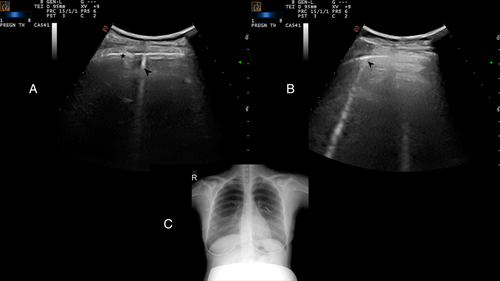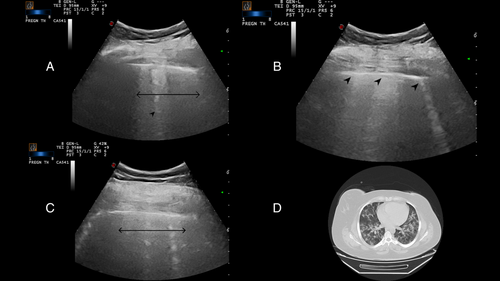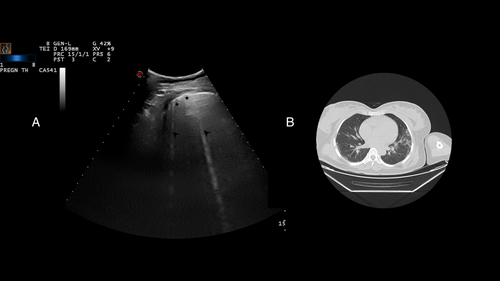- AI
- Molecular Imaging
- CT
- X-Ray
- Ultrasound
- MRI
- Facility Management
- Mammography
Lung Ultrasound Can Direct COVID-19 Treatment in Pregnant Women
The modality is an effective, reliable alternative to chest CT or chest X-ray in this vulnerable population.

Abnormal bilateral LUS findings in a patient with negative CT findings 1 week before admission. The double‐headed arrow indicates a generalized white area, and a sporadic B‐line is also seen (A ; arrowhead). Arrowheads indicate a thickened and disrupted pleural line and associated multiple B‐lines (B ). A generalized white lung pattern classified as score 3 is indicated by the double‐headed arrow (C ). Typical ground glass opacities on CT of the same patient are shown (D ).Courtesy: Journal of Ultrasound in Medicine

Abnormal LUS findings in a woman with an initial rRT‐PCR testing. Stars indicate the pleural irregularities and subpleural small consolidations, and arrowheads indicate sporadic B‐lines (A ). Chest CT findings were reported to be consistent with viral pneumonia with regard to ground glass opacities in all segments (B ). Courtesy: Journal of Ultrasound in Medicine

The usefulness and role of lung ultrasound in the COVID-19 pandemic continues to evolve with a newly published study showing that use of the modality can change the treatment protocols for pregnant women who have viral infection.
Published in the June 1 Journal of Ultrasound in Medicine, investigators revealed that findings from lung ultrasound changed the treatment course of 87 percent of pregnant women who also had COVID-19 infection. Although the study only included eight women, all of whom had RT-PCR tests positive for COVID-19, the research team believed it is the largest series of case studies currently available looking at how well the modality works with this patient group.
“Performing lung ultrasound examinations on patients infected with COVID-19 is an emerging trend, considering its effectiveness,” wrote investigators, led by Murat Yassa, M.D., from the Sancaktepe Training and Research Hospital in Istanbul, Turkey.
As a reliable, radiation-free imaging method that can detect pathologic lesions before hypoxia occurs and can reduce the need for chest X-rays, they said, it is well suited for imaging vulnerable populations, particularly pregnant women. Additionally, they said, obstetricians are already familiar with and proficient in conducting lung ultrasound, potentially reducing the workload for radiologists and further minimizing the risk of viral transmission throughout the hospital.
The team’s findings indicated the women in the study were more comfortable with lung ultrasound than with chest CT or chest X-ray despite the levels of radiation being “relatively safe” during pregnancy. In fact, three women who had mild COVID-19 symptoms declined chest CT or chest X-ray, citing the risk for their unborn child and their breasts, but they agreed to lung ultrasound.
According to the study results, seven of the eight women enrolled had serious lung involvement, and two were asymptomatic. Based on the results for the lung ultrasounds, doctors initiated treatment in five women and changed protocols in two. Seven women had successful deliveries; one woman experienced an early, missed miscarriage.
Given these findings, the team said they recommended lung ultrasound under three specific circumstances:
- Asymptomatic patients with positive RT-PCR results for whom CT is not planned
- Patients with mild symptoms who do not give consent for chest CT
- Ultrasound surveillance of asymptomatic patients with initial negative CT findings or follow-up of the treatment response in symptomatic patients
New CT and MRI Research Shows Link Between LR-M Lesions and Rapid Progression of Early-Stage HCC
January 2nd 2025Seventy percent of LR-M hepatocellular carcinoma (HCC) cases were associated with rapid growth in comparison to 12.5 percent of LR-4 HCCs and 28.5 percent of LR-4 HCCs, according to a new study.
The Reading Room: Racial and Ethnic Minorities, Cancer Screenings, and COVID-19
November 3rd 2020In this podcast episode, Dr. Shalom Kalnicki, from Montefiore and Albert Einstein College of Medicine, discusses the disparities minority patients face with cancer screenings and what can be done to increase access during the pandemic.
Can AI Facilitate Single-Phase CT Acquisition for COPD Diagnosis and Staging?
December 12th 2024The authors of a new study found that deep learning assessment of single-phase CT scans provides comparable within-one stage accuracies to multiphase CT for detecting and staging chronic obstructive pulmonary disease (COPD).
Study Shows Merits of CTA-Derived Quantitative Flow Ratio in Predicting MACE
December 11th 2024For patients with suspected or known coronary artery disease (CAD) without percutaneous coronary intervention (PCI), researchers found that those with a normal CTA-derived quantitative flow ratio (CT-QFR) had a 22 percent higher MACE-free survival rate.
